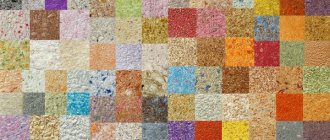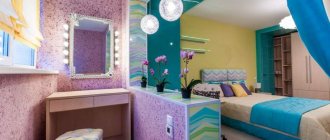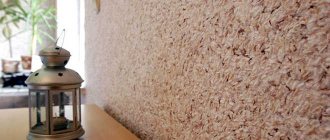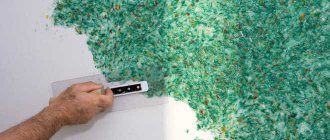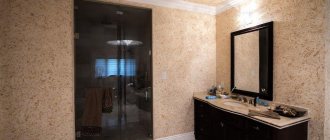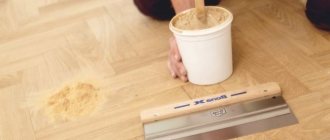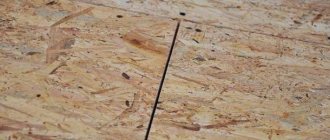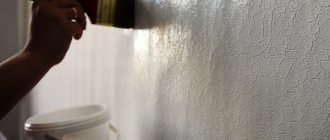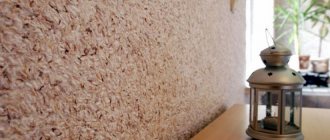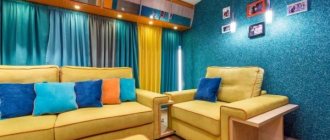Home Wall Repair
Liquid wallpaper is a popular material widely used for wall coverings. Its distinctive feature is that the finish is applied with a spatula and is a kind of mix of traditional wallpaper and putty. They are made from various natural fillers, pigments and wallpaper glue. To apply to the wall, the mixture is first diluted with warm water.
The dry mixture for liquid wallpaper should be stored in a dry, dark place in a hermetically sealed bag!
You can purchase liquid wallpaper in the form of a dry mixture in transparent bags weighing from 1 kg. Recommended requirements for short-term storage are usual: it is enough to place them in a dry, dark place in a bag without access to air. At the same time, there are some peculiarities, knowledge of which will help you preserve any quantity in its original form.
If you still have liquid wallpaper after treating all the walls, do not rush to throw away the solution. It can be dried and added to leftovers for storage and emergency repairs.
How to spread liquid wallpaper
Dilute liquid wallpaper with ordinary water at room temperature.
You will need a plastic container (basin or bucket).
Volume from 12 liters, for mixing one package. With a smaller volume, mixing liquid wallpaper is not convenient, and it will fall over the edge. You can soak the packages individually or several at once. When soaking more than 1 package at a time, keep in mind that you will need a fairly large container - 20 liters or more. The basin or bucket must be clean, free of foreign odors.
Plastic construction buckets from 12 liters are ideal for soaking liquid wallpaper.
The water consumption of each series of liquid wallpaper is indicated on the back of the package.
If you purchased decorative additives separately (glitter for liquid wallpaper), pour them into water before spreading the liquid wallpaper.
Add glitter to the water before mixing the liquid wallpaper.
Open the package and pour the contents into water.
It is NOT RECOMMENDED to dilute part of the liquid wallpaper package in water. Soak the entire package, otherwise uneven distribution of glue and decorative additives may occur.
Pour the entire contents of the package into water
Thoroughly mix the liquid wallpaper until you obtain a homogeneous mass, reminiscent of minced meat in consistency.
Mix thoroughly until smooth
Do not use construction mixers or other mechanical means for mixing, they can damage the structure of the material.
After obtaining the required consistency, place the kneaded mixture in a plastic bag or cover with film.
Place the soaked liquid wallpaper
Instructions for applying Silk Plaster - SILK PLASTER
Applying Silk Plaster liquid wallpaper is a simple procedure. Any home craftsman without special training can apply SILK PLASTER to walls and ceilings. 10-15 minutes of training and applying plaster will give you pleasure! > Familiarize yourself with the necessary tools and materials.
Below is a video clip with detailed instructions on how to apply liquid wallpaper.
Briefly about the main thing
- First you need to prepare the surfaces of the walls and ceilings. They are prepared as for regular painting: that is, they must be plastered, puttied and primed. You can, of course, not putty the walls, given that “SILK PLASTER” itself is plaster. It will cover all the unevenness of the wall and you will save on puttying. You just need to understand that there will be more of it, you need to take it with a reserve. It is ideal when SILK PLASTER is applied to new drywall. In this case, it is enough to coat the drywall with any primer. But if the drywall is attached to the wall with self-tapping screws, then it is necessary to cover it with two layers of SILK PLASTER primer (5 kg/25 sq.m. in two layers ), since the heads of the screws may appear in the form of rusty spots.
- In the case when liquid wallpaper is applied to an old wall where there was wallpaper or painting, the procedure for preparing the wall is as follows:
- clean the walls of old wallpaper,
- use a steel brush to tear through the wall, removing a microscopic layer of plaster on which remains of wallpaper glue from the removed wallpaper and from the previous ones are preserved,
- wipe the wall with a damp cloth or sponge to remove dust, constantly squeezing the sponge in clean water,
- to a dry wall , and for white wallpaper it is better to use three layers, crosswise (for example, one layer vertically, the other horizontally). The primer is applied to protect SILK PLASTER liquid wallpaper from traces of old wallpaper glue (these traces appear in the form of yellow streaks and spots), from self-tapping screws, screws, fittings that are not visible on the wall surface, but since liquid wallpaper dries for two days, they wet the surface of the wall by almost a centimeter and, when drying, they can pull all this onto themselves in the form of rusty spots.
- You can apply liquid wallpaper to old oil paint , but it must be sanded and primed with SILK PLASTER primer. If you do not have this primer, then, as an exception, you can use 2 parts of facade VD paint and 1 part of PVA glue, mixing them together until you obtain a homogeneous creamy mass, which you need to cover the walls twice for priming.
Protection of liquid wallpaper:
- As we said earlier, to protect liquid wallpaper from what is in the wall and on the wall, our company offers you a branded primer SILK PLASTER
.
It is odorless, colorless and dries quickly. Applying it in 2 - 3 layers crosswise provides reliable protection. SILK PLASTER primer is not tinted and forms a matte, rough surface after drying.
- SILK PLASTER plaster for the first time, we recommend starting from the place on the wall where it is most convenient for you to do it, for example, at eye level. Having finished covering the wall from corner to corner, we advise you to clean the trowel, moisten it in clean water and move the trowel over the entire wall with light stroking circular movements, constantly wetting it in water. This will make the surface smoother and more even without trowel marks.
PREPARATION OF SILK PLASTER PLASTER
- In order to prepare SILK PLASTER plaster, you need a construction bucket or basin, or any container larger than 16 liters and tap water.
- Pour 4.5 liters of warm water into a bucket.
- Pour a bag of glitter into the water, if you need it, and stir. The water will turn golden or silver depending on the color of the glitter.
- Pour the entire package of liquid wallpaper into the water, press down with your hands so that the entire mass is saturated with water, lightly mix and put the entire mass back into the same bag.
- Take the next package and repeat the whole procedure again.
- So you soak all the packages for a given room, with the exception, perhaps, of the last package, what if it is superfluous, why soak it? You can always cook it.
- You leave the soaked bags for 10-12 hours, so it is better to carry out the soaking procedure in the evening and leave the bags to soak until the morning.
- In the morning, take as many soaked bags as will fit in your bucket, dump them into the bucket and mix thoroughly, straining through your fingers. You can work without gloves, since the solution is environmentally friendly, non-allergenic, and your hands will look as if you had covered them with hand cream.
- After using two-thirds of the bucket's volume, take the remaining bags and add them to the bucket until it's full, mixing with the rest.
Adding plain paper to the mixture
You can prepare the required composition for wallpaper yourself, following the above recommendations and instructions for use, adding a variety of fillers to the composition.
One of these fillers can be plain paper. The solution with paper is mixed as follows:
- Plain paper is shredded and filled with water. For 1-1.5 liters of water, approximately 40 sheets of paper are needed.
- The mixture is left to soak for about an hour. The finer the sheets are cut, the less time it takes to soak, and vice versa.
- Thoroughly stir the paper in the water.
- Mix the desired color into the resulting mixture.
- Add 40 tablespoons of gypsum to the solution, mixing thoroughly.
- Pour 200 ml of PVA glue into the mixture, also stirring thoroughly.
- Add decorative components to the solution: glitter, pieces of marble, various fibers.
After thoroughly mixing the finished mixture, a test application of liquid wallpaper is performed on a small section of the wall. If necessary, various components are added to the mixture to adjust its consistency and color.
Depending on how the mixture is distributed during installation, the composition is adjusted. If the finished surface peels, then glue is added to the composition; if it cracks, the volume of minerals is increased.
Removing liquid wallpaper from walls
Choosing a spatula for liquid wallpaper
Using wallpaper under Venetian plaster
What to do if you don’t like the color
Of course, it often happens that the color in the picture differs from the finished result.
What to do if you are not satisfied with the final shade? Another positive aspect of liquid wallpaper is that it can be painted. Accordingly, if you are not satisfied with the tone or color scheme, you just need to buy special paint and apply it with a regular roller.
In addition, wallpaper can be varnished. This will help preserve them better and allow you to wash them if necessary.
The finished result will look very original and interesting. The main disadvantage of all such actions is that purchasing the necessary materials will not be cheap.
If necessary, the wallpaper can be repainted
As you can understand from all of the above, working with liquid wallpaper is quite pleasant and simple. The main disadvantages are their cost; to renovate a large room you will need to spend a considerable amount. In addition, when talking about preparing the material, emphasis should be placed on the fact that you need to correctly calculate its quantity. Otherwise, it may turn out that there is too much of the finished product left, and it will not be stored for a long time.
Mixture consumption
Before starting to mix the composition and how to apply liquid wallpaper , it is necessary to determine as accurately as possible the consumption of material per unit area so that the prepared mixture is enough to cover the entire surface planned for wallpapering and there is no excess volume left that will be thrown away.
The consumption of liquid wallpaper per 1 m2 is indicated on the packaging of the material, but this is a relatively dry composition; when the components are dissolved in water, this value will be higher. In practice, this indicator will correspond to the data given in the table:
READ Inward opening entrance doors
In addition, this indicator may depend on the degree of preparation of the walls:
- if the walls are perfectly smooth, the mixture consumption will be minimal;
- if there are sinkholes, potholes, cracks and other defects on the walls, then the consumption of liquid wallpaper will increase in proportion to the number and volume of existing coating defects.
Liquid wallpaper to level walls or fill any defects on them.
Liquid wallpaper is not suitable for leveling walls
For these purposes, it is necessary to use plaster and putty compounds specially designed for this purpose.
If after work there is still unused liquid wallpaper in the form of a mixture and in the future it is necessary to carry out work on applying it to other surfaces, then it can be stored in a closed container for several weeks.
LIQUID WALLPAPER❗REUSE RESTORATION OF LIQUID WALLPAPER
Proportions and general tips
Material from different manufacturers may require the use of a certain amount of water to dilute them. However, in most cases, the proportions are: for 1 package, mix from 2.5 to 7.5 liters of liquid. As a rule, each package comes with its own instructions, which it is recommended to read in advance.
Using the material is quite simple. Required:
- Pre-prepared surface.
- Dry mixture.
- Water.
- Container for wallpaper.
After soaking, the material takes time to become wet and swell. As a rule, this takes about 12 hours. Afterwards it will be possible to apply it to the wall.
Wallpaper must be applied carefully and slowly to avoid unnecessary waste of material. For the next 2 days, it is necessary to protect the treated room from drafts and excessive humidity.
It is better to dilute in a separate container
Composition of liquid wallpaper and delivery options
, beads, mother-of-pearl, and silk fibers are added to liquid wallpaper
Liquid wallpaper contains natural components in the form of fibers, which create a surface that is pleasant to the touch and resembles decorative plaster in appearance.
Also, thanks to the materials that make up liquid wallpaper , they are safe for health, multifunctional and fit quite harmoniously into any modern interior.
The components included in liquid wallpaper can be the following:
- fibers from silk, cellulose or from an artificial base: wool yarn, silk, cotton, acrylic, CMC glue;
- decorative elements: beads, mother-of-pearl, mica, glitter;
- mineral fillers;
- colored quartz;
- antiseptics and adhesives;
- multi-colored granules, stone chips, colored threads.
Mixtures for preparing liquid wallpaper are prepared in the factory. Liquid wallpaper can be sold in the following forms:
- the materials included in the liquid wallpaper are pre-mixed, and after adding water and thoroughly mixing the resulting mixture, the composition for applying liquid wallpaper is ready;
- materials are provided in separate containers that must be mixed strictly following the instructions.
Also, at the request of the owner of the premises being repaired, additional materials from those listed earlier can be added to the composition of ready-made mixtures or mixtures mixed from components prepared at a specialized enterprise.
Liquid wallpaper can be prepared and diluted independently.
Storing liquid wallpaper using the “dry” method
Let's now consider how long to store diluted liquid wallpaper ? In diluted form, as we have figured out, liquid wallpaper cannot be preserved. At the same time, the technology itself involves the restoration of the building mixture and its subsequent storage and use.
- Take a clean piece of plastic wrap and lay it on the floor.
- Apply the remaining mixture of liquid wallpaper onto the polyethylene in a fairly thin layer using a working plastic spatula.
- Allow the mixture to dry completely; 24 hours at room temperature is usually sufficient.
- After this, roll up the polyethylene, remember it, the particles of the mixture will easily come off and will be restored to their original form.
- The reconstituted mixture is placed in a bag, the air is released and tied tightly.
- The dry mixture can be stored in a sealed bag indefinitely.
Please note that it is better to store in separate bags, otherwise the result of application will differ from that declared by the manufacturer!
This storage method is convenient and compact. The process of restoring the dry mixture itself does not require effort or a large area for drying. Therefore, it is not recommended to dilute more than necessary for work during a work shift.
Advantages and disadvantages of liquid wallpaper
Like any other material used for decoration, liquid wallpaper has both positive and negative qualities.
The following advantages stand out:
- The material is environmentally friendly, so it is well suited for use in children's rooms.
- It is applied in a single format and does not imply the presence of joints and seams.
- Levels walls and is applied to the most problematic areas.
- Suitable not only for walls, but also for ceilings or inclined surfaces.
- Resistant to temperature changes.
- The material is an air humidity regulator.
- Resistant to mold.
- Do not fade when exposed to sunlight.
- Easy to replace and minor repairs.
- There is no unpleasant or pungent odor.
The fact that any defects can be easily corrected with ordinary water is also a disadvantage. Liquid wallpaper reacts quite poorly to excess moisture and can deteriorate.
As for the disadvantages, it is worth highlighting the following:
- Not suitable for finishing open spaces, balconies, facades.
- The cost is higher than that of rolled wallpaper.
- After application, drying the room takes from 1 to 3 days.
- They have low abrasion resistance.
- Without a special varnish coating, cleaning the walls can only be done with dry wipes or a vacuum cleaner.
Easy to use
Preparation of liquid wallpaper
Preparation of the working mixture for applying liquid wallpaper to walls must be done in advance, since the finished mixture can be stored in a hermetically sealed container and even in a plastic bag for several weeks.
To make it convenient to work with the prepared composition, it must be kept for 8-12 hours. During this period of time, the mixture will acquire a consistency at which the liquid wallpaper can be evenly distributed over the surface.
READ Cedar house pros and cons
Use warm water for kneading
Mixing the components of liquid wallpaper with water must be done in strict accordance with the instructions and compliance with the following requirements:
- The required amount of water is poured into a pre-prepared container.
- Water should be used at room temperature or slightly higher (20-35 degrees).
- Decorative elements must be placed in water and stirred first so that they can be evenly distributed throughout the mixture while mixing the composition
- Each packet of components is poured out and kneaded separately until completely dissolved.
- The contents of each package must first be kneaded to eliminate the presence of lumps, which will complicate the stirring process, or may not dissolve at all, thereby spoiling the entire mixture.
Mix the mixture with your hands
- Mixing the composition must be done by hand, since the use of hand or power tools can disrupt the long fibers used in preparing the solution.
- According to their manufacturers and suppliers, the components of the mixture do not contain harmful substances, so kneading can be done manually. Despite this, when kneading you still need to use personal protective equipment, namely rubber gloves.
- Mixing the mixture for one room must be done in one container to ensure uniform color of the composition used.
After preparing a test portion of the mixture, it is necessary to apply liquid wallpaper according to the application instructions on the surface to be treated and leave for some time to allow it to dry. For more information about kneading, see this
You cannot pour water into a dry mixture; on the contrary, you can gradually add dry ingredients to the water, stirring the solution evenly.
When adjusting the composition, you can experiment by increasing or decreasing certain components in the mixture.
Liquid wallpaper: removal with reapplication
Liquid wallpaper looks very beautiful on the walls, allows you to qualitatively transform the space and even create an additional sound and heat insulation layer in the room. The coating almost does not become dirty during operation, as it has antistatic properties. But it still sometimes happens that the decoration is removed from the wall. And the question arises - is it possible to reuse liquid wallpaper? Yes, you can, and we will tell you how.
How to clean a wall?
One of the most important properties of decorative plaster with cellulose and textile fibers is the ability of the material to swell and soften upon contact with water. This is the basis for tips on how to remove liquid wallpaper:
- First, the area of finishing that you will dismantle must be soaked with water. It is advisable to use warm water so that the adhesive component begins to interact with the liquid faster. To soak, you can use a damp sponge, lint roller or spray bottle.
- When the liquid wallpaper becomes plastic, it is removed from the wall with a large metal spatula.
- Place the plastic mass on polyethylene to dry. Try to remove contaminated areas.
How to reuse
After dismantling, liquid wallpaper must be dried. It is important to know how to preserve liquid wallpaper. To do this, spread the removed finish over a flat surface in a thin layer and leave to dry. You can even squeeze the water out of the removed trim to speed up the process. And after that, spread the liquid wallpaper on polyethylene so that the layer thickness does not exceed 3 cm (the thinner the better). If you are going to store the material for a long time, then make sure that it dries thoroughly. After this, it can be packed in transparent plastic bags. The shelf life of such finishing is practically unlimited - provided that there is absolutely no moisture left inside. Dry liquid wallpaper exclusively in air. But reusing liquid wallpaper is no different from the original one. Simply add a certain amount of water to the dry mixture, let it brew and mix with your hands. You may need additional CMC glue. As soon as the glue dissolves, the composition will swell, turn into a plastic mass and will be ready for use. In any case, you must understand that reused wallpaper may contain foreign elements (for example, putty) and therefore it is better to purchase new finishing material.
How Long Can Diluted Liquid Wallpaper Be Stored?
For vinyl wallpaper
The adhesive composition for vinyl wallpaper in diluted form cannot be stored for a long time. No matter how tightly the container with it is closed, over time processes occur in it that lead to a deterioration in its performance. Having prepared wallpaper glue, it is recommended to use it as quickly as possible. It is difficult to say how long it will last without losing its original properties. The product may deteriorate on the second day, or it may be perfectly preserved for 2 weeks. Experienced craftsmen claim that vinyl wallpaper adhesive can be stored
How to store leftover mixture
When dry, wallpaper is stored for quite a long time (up to several years). In other words, if necessary, they can later be taken out and used to fix problems that have arisen, for example, to fix a damaged piece.
The most important thing in this matter is the correct storage conditions. First of all, you need to make sure you have a dry plastic bag.
In this case, the wallpaper must be tightly closed to avoid the ingress of dust, dirt and moisture. In this form, they can be obtained and mixed in 2-3 years.
The diluted mixture is stored in a clean, dry bag.
How long to soak liquid wallpaper
As a rule, this will take 10 to 12 hours, but no more. This time is enough for the adhesive composition to completely dissolve in the mixture, which was diluted with water.
If you start applying the solution earlier, then incompletely dissolved glue clumps can seriously complicate finishing work. In addition, during drying, unpleasant spots may appear on the wallpaper, which will ruin the entire composition. Therefore, it is recommended to let the prepared mixture brew for 12 hours.
How to store liquid wallpaper: features and secrets
Liquid wallpaper is a popular material widely used for wall coverings. Its distinctive feature is that the finish is applied with a spatula and is a kind of mix of traditional wallpaper and putty. They are made from various natural fillers, pigments and wallpaper glue. To apply to the wall, the mixture is first diluted with warm water.
READ Is it necessary to prime drywall before wallpapering?
How to store diluted liquid wallpaper
The dry mixture for liquid wallpaper should be stored in a dry, dark place in a hermetically sealed bag!
purchase liquid wallpaper in the form of a dry mixture in transparent bags weighing from 1 kg. Recommended requirements for short-term storage are usual: it is enough to place them in a dry, dark place in a bag without access to air. At the same time, there are some peculiarities, knowledge of which will help you preserve any quantity in its original form.
If you still have liquid wallpaper after treating all the walls, do not rush to throw away the solution. It can be dried and added to leftovers for storage and emergency repairs.
Repair of damaged areas
Additionally, we will consider the issue of removing liquid wallpaper and subsequent repair of the area in case of damage. If you have unused dry mixture and the area of the coating is damaged, this can be fixed.
Typically, the damaged area is cleaned and the mixture is subsequently applied. No primer is required unless the top layer of plaster is affected. Otherwise, the area for application will need to be pre-prepared.
The intact mixture applied to the wall can be removed with a spatula and a utility knife, after first wetting the area with a sponge. Be sure to separate the mixture of areas of wallpaper that have changed color from each other.
Next, the pieces are soaked and reapplied. If necessary, the mixture is added from stored reserves. Thus, storing liquid wallpaper of the used brand is necessary precisely for unforeseen minor surface repairs. In the case of liquid wallpaper this is possible.
Preparing the mixture
Liquid wallpaper must be soaked with ordinary warm water, the temperature of which is approximately 15 °C. In order to complete this work, you will need a 12-liter container (for example, a plastic bucket or basin). It is recommended to prepare one package of the mixture, since with a smaller volume it will be inconvenient to mix liquid wallpaper . You can use larger containers, but then you will have to throw in several packs at once. Before starting work, the plastic basin or bucket should be thoroughly washed to remove foreign odors.
There is a reliable and proven option on how to properly soak liquid wallpaper , which requires the following steps:
Remains of liquid wallpaper, what to do? / Remains of liquid wallpaper, what to do?
Advantages
It is important to know not only how to dilute liquid wallpaper, but also about its benefits. The material is produced in different colors, different textures, with the addition of sparkles. The coating has excellent sound and heat insulation. In contact with fire, it protects against its spread.
Are there any differences in the preparation of wallpaper from different series?
There are 18 series of liquid wallpaper in our catalog. They differ in color, price, and application rate. Are there any differences in how to apply Silk Plaster liquid wallpaper (“Victoria”, “Nord” or “Recoat”)? Absolutely none, if you do not take into account the different volumes of water.
Modern technologies make it possible to create unique finishing materials that were previously impossible to dream of. More recently, a couple of decades ago, apartments and houses were decorated with simple paper wallpaper, which differed only in design. But nothing stands still, and today the materials for wall decoration amaze with their diversity. The usual options have been replaced by wallpaper, which is applied to the surface in liquid form. Therefore, many who heard about this type of finishing for the first time have a logical question: what is liquid wallpaper and how to apply it to the wall.
Sources:
https://slad-son.ru/raznoe/skolko-hranyatsya-zhidkie-oboi-v-razvedennom-vide.html
What kind of material is this
Page navigation
Liquid wallpaper has similar characteristics to conventional paper wallpaper, as well as decorative plaster. They are a dry mixture that is diluted with water.
After “preparation”, the composition is applied to the wall using special tools. The main difference from decorative plaster is the components of the mixture.
What is included in the main components:
- The binding material is glue. Most often the composition includes CMC.
- Filling, which can be cotton or cellulose.
- Dye.
- Additional decorative elements. It can be sparkles, mother-of-pearl, natural or artificial granules, and so on. Today the choice is extensive.
Working with such material is quite simple and convenient. If desired, the damaged area of wallpaper can be easily replaced. To do this, they are simply wetted, removed and replaced with a fresh composition. In addition, painting is allowed.
Some particularly talented artists even create multi-layered designs using different colors.
The advantage of wallpaper is that it can be applied in a variety of ways, including using lines, complex shapes, and so on.
The main advantages of the material
